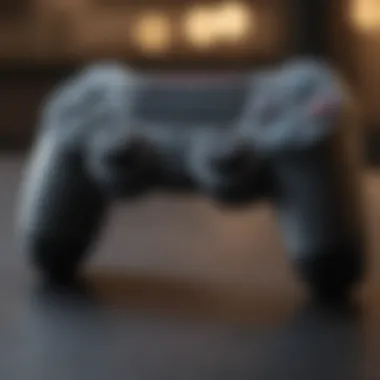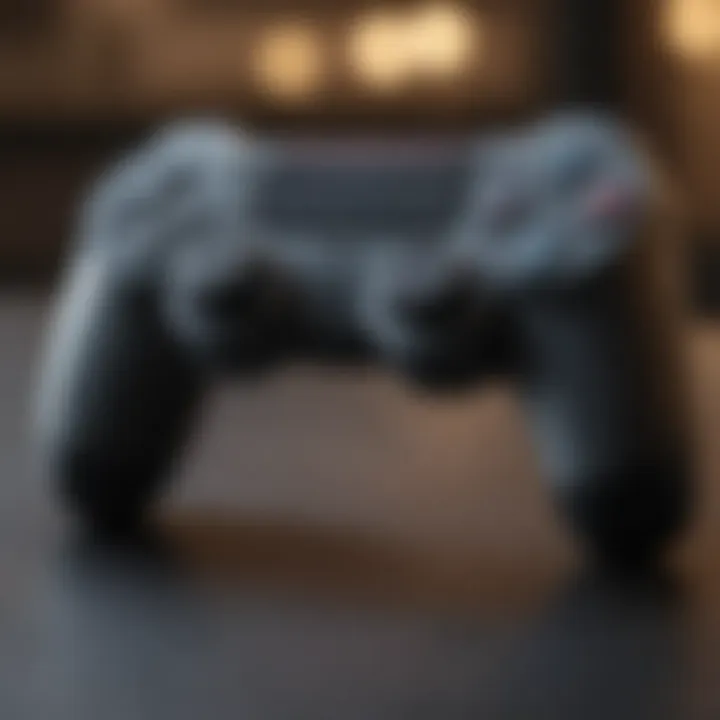Ultimate Guide to Wireless PS Controller for PC Gaming


Intro
The integration of wireless PS controllers for PC gaming has transformed the landscape for gamers. No longer bound by wires and cables, players can enjoy a versatile and dynamic gaming experience. This guide explores everything crucial about utilizing a wireless PS controller in a PC setup. Readers will discover the compatibility inquiries, setup processes, and unique features associated with various models.
By delving deep into the capabilities of wireless PS controllers such as the DualShock 4 and the DualSense, this guide aims to empower gamers. Whether they are seasoned players or newcomers aiming for an optimized gaming experience, referrals to advanced configurations create paths for enhanced gameplay.
Overview of Wireless PS Controllers
Wireless PS controllers serve as a bridge between console and PC gaming environments. The notion of coupling the iconic controllers like the DualShock 4 and DualSense with PC systems has gained plenty of attention in the gaming community. While designed primarily for PlayStation consoles, these controllers exhibit broad support for PC gaming through native Bluetooth functionality.
Most contemporary games, from action to role-playing, recognize these controllers without significant configuration. Each controller comes packed with features such as motion sensing and touchpads, enhancing how users interact with games.
Features of Wireless PS Controllers
Wireless PS controllers come equipped with several crucial functions that cater to modern gamers.
- Bluetooth Connectivity: Enables a seamless wire-free connection with PCs.
- Touchpad: Provides additional input options, enhancing gameplay mechanics.
- Motion Sensors: Enhance immersion in specific gaming genres, especially racing or first-person shooters.
- LED Light Bar: Offers visual feedback by indicating controller status and other in-game cues.
Combining these features, a wireless PS controller can elevate gameplay through more intuitive engagement and interaction with digital landscapes.
Compatibility Considerations
Before diving headfirst into adoption, users must consider compatibility. The following factors are essential:
- Windows Version: PC must run Windows 8 or above for perfect functionality with most PS controllers.
- Game Support: Not all titles support controller inputs, hence checking game specifications is vital.
- Driver Installations: Installation usually happens automatically when the controller connects for the first time, but manual driver updates might be required in some cases.
An understanding of these compatibility systems is key for gamers eager to bypass potential frustrations during setup.
Setup Procedures
Establishing connectivity between a wireless PS controller and your PC involves straightforward steps:
- Activate Bluetooth on Your PC.
Navigate to the settings and ensure Bluetooth is enabled. - Enter Pairing Mode on Controller.
Press and hold the Share and PS buttons until the light bar begins to flash. - Connect via Bluetooth Settings.
Select the controller from the available devices. - Test the Connection.
Initiate a game and confirm functionality to ensure everything runs smoothly.
Setting up requires vigilance but remains user-friendly for dedicated gamers.
Performance Insights
Performance analysis of wireless PS controllers reveals advantages and subtle limitations. Feedback from users indicates the responsiveness, ergonomics, and longer play sessions stand out positively. However, some users report occasional latency or connectivity issues depending on the environment, especially in areas rife with electronic interferences.
Nonetheless, it's critical to weigh the multitude of advantages against individual preferences and expectations. With proper usage and setup, the switch to a wireless PS controller can redefine conventional PC gaming experiences significantly.
In sum, enhancing PC gaming through a wireless PS controller can prove beneficial for numerous players. This detailed exploration highlights the considerations vital for understanding about integrated setups to warrant a rich gaming experience.
Intro to Wireless PS Controllers
Wireless PS controllers play a crucial role in how modern gamers interact with their PCs. The transition to wireless technology создал не только free movement but also improved comfort and usability. As gaming becomes increasingly accessible and user-friendly, understanding the intricacies of wireless PS controllers is of great importance.
A wireless PS controller offers unique benefits for gamers. It provides the convenience of eliminating cables, which can be cumbersome and limit movement. This advantage enhances the overall gaming experience, allowing players to immerse themselves fully in their environments without distractions caused by tangled wires or limited mobility.
Yet, no technological advancement comes without considerations. Factors such as compatibility with different systems, setup procedures, and performance aspects need to be examined critically. Knowledge of these areas can help gamers avoid common pitfalls and choose the optimal equipment for their setup.
In the following sections, we will delve into these essential aspects of wireless PS controllers. This will include an understanding of wireless technology as it relates to controllers and a historical perspective of the evolution of PS controllers themselves.
Compatibility with PC Systems
Understanding the compatibility of wireless PS controllers with PC systems is vital for maximizing your gaming experience. Selecting the right controller plays a significant role in how effectively you can navigate games, achieving smoother controls and reduced frustration.
Supported Operating Systems
Compatibility begins with the operating system of your PC. Most wireless PS controllers are designed to be compatible with major operating systems like Windows and macOS. However, how you connect these controllers may vary.


- Windows: Windows 10 and Windows 11 generally come with built-in support for both DualShock 4 and DualSense controllers, allowing them to connect easily via Bluetooth or USB. These systems recognize the classic controller functionalities seamlessly.
- macOS: Devices running macOS Monterey or later also support wireless PS controller connectivity, provided you utilize the latest updates and proper settings adjustments.
Key Points:
- Ensure your computer runs on an operating system that supports your chosen language and translation.
- Connecting can differ depending on hardware or utilized software, as diverse devices may have unique limitations.
Hardware Requirements
Beyond compatible software, hardware aspects are equally crucial. Specific hardware capabilities on your PC can determine how well the wireless PS controller functions.
- USB Ports: At the minimum, having functional USB 2.0 ports is essential. This aspect impacts wired connections or setup via a USB dongle.
- Bluetooth Capability: Ensure that your PC has Bluetooth functionality built-in. Wireless controllers seek connections through Bluetooth, and absent hardware means loss of this feature.
- System Resources: Adequate RAM and processing power usually enhance controller performance. Users must note that older or less capable machines may encounter higher input lag or limitations.
Third-Party Software and Drivers
While most users appreciate the out-of-the-box compatibility of PS controllers, many situations require additional software to optimize performance.
- Steam: The Steam platform includes built-in support for PS controllers. Users can configure button mappings and access unique features that improve gameplay.
- DS4Windows: This third-party application provides detailed adjustments, such as adjusting light up and customizing profiles. It helps bridge gaps for functions that may slip through typical support.
- InputMapper: Another utility for controller mapping, making even advanced settings intuitive for usage. Users employ InputMapper to adjust settings more granularly, which is beneficial in complicated games.
With the right compatibility understanding, you enhance your ability to gauge the features and optimize integration in your gaming environment. By following the compatibility guidelines, you reduce obstacles that distract from your gaming experience.
Setup Process
Setting up a wireless PS controller for your PC is significant for optimizing the gaming experience. Understanding this procedure helps ensure seamless connectivity and functionality with your favorite games. Efficiency in setup leads to less time grappling with connection issues and more time enjoying gameplay. This section will cover important methods for connecting a controller - via Bluetooth, USB dongles, and adjusting game settings.
Connecting via Bluetooth
Bluetooth connectivity offers a standard method for pairing a wireless PS controller with a PC. Before starting, ensure your Windows operating system supports Bluetooth, as this feature is not universal among all models. To connect, follow these general steps:
- Activate Bluetooth: Open the Windows settings and navigate to the Bluetooth section. Turn it on if it’s disabled.
- Put the Controller in Pairing Mode: You need to press the PlayStation button and the Share button simultaneously until the light bar starts to flash.
- Add a Device: In the Bluetooth settings of your PC, select “Add Bluetooth or other device” to search for the controller.
- Complete the Pairing: Once your controller appears in the list, select it to complete the connection.
Ensure the controller is fully charged to prevent power-related disconnections during this process.
Using USB Dongles
Using a USB dongle is another popular method for establishing a connection between your wireless PS controller and PC. An official dongle generally provides a stable signal, reducing issues that may arise with Bluetooth.
To connect using a dongle, adhere to the following steps:
- Insert the USB Dongle: Connect the dongle to an available USB port on your PC.
- Power on the Controller: You ought to turn on your controller by pressing the PlayStation button.
- Automatic Connection: The controller typically will detect the dongle and auto-connect after a brief moments.
This connection offers less latency than wireless Bluetooth since it uses a dedicated connection path.
Configuration in Game Settings
After establishing a connection, configuring the controller within specific game settings is vital. Each game may have distinct input options, and some fine-tuning ensures that players gain the best experience possible. Here are steps to consider during configuration:
- Access Control Settings: Start by going to the settings or options menu of the game in question. Look for “Controls”, “Input”, or similar terms.
- Assign function: Ensure each function of the wireless PS controller corresponds correctly. Various games may not automatically map controllers to control schemes, and manual input may be essential.
- Save and Test Configuration: Once settings are adjusted, save them, and do a quick gameplay test to verify that all functions respond accurately. Adjustments can be made in real time depending on personal comfort level.
Investing the time to understand these setup processes yields valuable rewards, amplifying daily mechanics to elevate gaming enjoyment. Consider individual needs when selecting between connection types. Succeeding in gaming can require meticulous setups, but the results often justify that expenditure of effort.
Advantages of Using Wireless PS Controllers
Wireless PS controllers bring many benefits that significantly enhance the gaming experience. Here, we explore three crucial aspects: freedom of movement, ergonomic design, and versatility across platforms. Each dimension contributes to making gaming more enjoyable and accessible.
Freedom of Movement
One of the most appealing features of wireless PS controllers is the freedom they provide. Gamers no longer have to deal with tangled wires or restrictive lengths. This liberates the player, allowing more variability in their position while gaming. Whether lounging on a couch or sitting at a desk, players can enjoy the comfort of movement without being tethered to the console. Wireless technology, primarily Bluetooth, offers a stable connection with an increased range compared to traditional wired controllers. The effective radius can extend to around ten meters, permitting interaction with screens at different distances.
Ergonomic Design
Comfort is key for long gaming sessions, and PS controllers do not disappoint. Manufacturers consider ergonomics when designing these controllers. Buttons are typically well-placed for easy access, reducing strain during gameplay. The handles also have contours that fit snugly in hand, promoting relaxation. This quality is especially important for gamers who spend hours playing without fatigue. For gamers seeking high-performace over extended durations, a good design helps maintain focus and dexterity that consistent gaming demands.


Versatility Across Platforms
Many gamers enjoy multiple gaming systems. One key advantage of wireless PS controllers is their compatibility beyond just PlayStation consoles. These controllers can connect not only to PCs but also other devices like mobile phones and tablets. For instance, the DualShock 4 controller can connect to various devices seamlessly. This versatility saves users from needing separate controllers for separate platforms, thus simplifying the gaming environment.
The adaptability of wireless PS controllers empowers gamers to play their favorite titles on various platforms with the same convenient controller.
In short, employing a wireless PS controller enhances not just the experience but also caters to convenience and comfort. Their ability to combine design with functionality meets the needs of diverse gamers effectively.
Performance Considerations
The performance of a wireless PS controller plays a significant role in determining the overall gaming experience. Gamers face various demands during gameplay. Latency, battery performance, and the build quality of the controller all play crucial parts in maintaining optimal performance. Understanding these factors can result in smoother gameplay, reduced frustration, and better game immersion. Addressing concerns around each factor ensures that players can make informed choices and enjoy seamless interactions with their favorite games.
Latency Issues
Latency refers to the delay between when a player inputs a command and when that action is reflected in the game. Wireless controllers can sometimes have higher latency compared to wired options. This can be particularly evident in fast-paced or competitive gaming scenarios. To maximize responsiveness, consider the following factors:
- Bluetooth Version: Newer Bluetooth standards, such as Bluetooth 5.0, offer lower latency and improved connectivity. Make sure your system and controller are on compatible standards.
- Interference: Other devices operating on the same frequency can cause interference. Ensure minimal obstructions and reduce the number of active devices to improve connection stability.
- Distance: Staying within an optimal distance from the PC can help, as increased distance can introduce more latency.
Maintaining Low Latency
Below are simple steps to maintain low latency:
- Use a controller with advanced features that emphasize low-latency communication.
- Choose gaming environments that minimize interference.
- Regularly update your controller firmware when software updates are available.
Battery Life and Charging
Battery life is another vital performance consideration when using a wireless PS controller. A controller that frequently runs out of charge can disrupt gameplay, leading to unintended breaks or potential disadvantages in competitive situations. Understanding the battery specifications can help players prepare accordingly.
- Average Life: The DualShock 4 offers approximately 4 to 8 hours of gameplay on a full charge, while the DualSense can last even longer.
- Charging Methods: Most PS controllers utilize micro USB cables for charging. Ensure to have spare cables available for convenience. Some models now support USB-C, providing faster charging encoding.
- Innovative Solutions: Consider third-party charging docks that can recharge controllers quickly,提高 Wi-Fi signals and decrease interruptions during play.
Durability and Build Quality
Durability is an essential aspect of any gaming controller's performance, especially for those who engage in extensive gaming sessions often through hours-long marathons. A sturdy controller not only represents an investment but helps avoid what could be extensive repair or replacement costs.
Key points recounting build quality include:
- Materials Used: Quality plastic and internally reinforced components often shape overall longevity. Search for consumer reviews focusing on long-term usage scenarios.
- Button Integrity: Controllers susceptible to constant use may experience wear and tear over time. Ensure button feedback and little stick drift remain optimal over time is another critical consideration.
- Environmental Resilience: Factors like spill and dust resistance can segregate the resilience of higher-end devices from lower-value options.
Through tips on selecting durable models, you could prolong your investment. An option worth noting includes the research necessary to find solid community reviews and guides on how similar models have held up for others over extended gameplay periods.
Popular Models of Wireless PS Controllers
Understanding the various models of wireless PS controllers is essential for gamers looking to elevate their experience on PC. The market offers different options, each with distinct features. Certain models stand out due to their popularity and performance, making them preferred choices among gaming enthusiasts. Selecting the appropriate controller can significantly affect gameplay effectiveness and comfort.
DualShock Features and Insights
The DualShock 4 remains a staple for many PC gamers. Notably, it presents an array of features. Firstly, its touchpad allows for enhanced interaction in compatible games. This grants players versatile controls. Secondly, the built-in speaker provides auditory cues, adding a layer to some gameplay scenarios. The controller's vibration feedback delivers a more immersive experience as well, simulating real actions from the game.
Furthermore, the ergonomic shape facilitates extended gaming sessions without discomfort. Being lightweight and easily grasped, it suits long gameplay requirements. According to user reviews on forums like Reddit, many appreciate the seamless connectivity, achieving reliable performance during intense gaming situations. Overall, the DualShock 4 balances performance and comfort quite well.
DualSense Controller Analysis
Ther DualSense controller introduces innovative functionality that enhances user interaction. The hallmark of this model is its adaptive triggers. They dynamically offer resistance based on in-game actions. This feature allows an unprecedented level of realism and connection to actions like shooting or braking a car.
Additionally, the DualSense features haptic feedback technology. This creates detailed experiences through physical sensations - for instance, feeling the difference between walking on grass compared to rough terrain.
The build quality has also improved compared to its predecessor. Its robust structure aims for durability. Some users may find the larger grips better fit for different hand sizes. All these elements amalgamate to create a truly immersive experience that can align well with the requirements of PC gaming.
Comparison of Available Options
Each model has specific advantages and suits various playstyles. Here's a brief comparison of the popular options:


- DualShock 4: Known for its established reliability.
- DualSense Controller: Latest in technology, emphasizing immersion.
- Features: Touchpad, built-in speaker, ergonomic design.
- Compatibility: Works well across multiple platforms.
- Features: Adaptive triggers, advanced haptic feedback.
- Usage: Best for modern games designed to leverage itsDualSense capabilities.
In deciding among these models, consider factors like gameplay type and personal preference. The choice ultimately can dictate how well a controller enhances the gaming experience.
Here is an order list of teir key diferences:
- DualShock 4 – Good for general gaming, versatile.
- DualSense – Best for newer titles, immersive features.
Understanding these popular models enables gamers to choose the best fit for their gaming needs effectively.
Troubleshooting Common Issues
Addressing common issues encountered with wireless PS controllers for PC is crucial for maintaining an optimal gaming experience. Gamers must understand potential connectivity problems, input delays, and software compatibility difficulties that may arise. Recognizing these issues can significantly enhance gameplay fluidity and improve overall satisfaction while gaming. Below are some typical problems users might face, along with effective solutions.
Connection Problems
Connection problems often frustrate gamers, as they can disrupt gameplay unexpectedly. One frequent scenario includes the controller not connecting to the PC. This may be due to several factors. First, ensure that the Bluetooth feature on the PC is enabled. Without Bluetooth turned on, communication between the controller and the device will not occur.
Another cause can be interference from other wireless devices. Keeping the PS controller closer to the receiver can solve this. Also, if users connect via USB dongle, checking the pairing process is essential. If temporarily disconnecting and reconnecting the device does not resolve the issue, it may be necessary to reset the controller. To do this, press the small reset button located on the back of the controller.
Input Lag Solutions
Gamers often notice input lag when using wireless controllers. This delay can affect reactions, especially in fast-paced games. Primarily, the type of connection influences this lag; Bluetooth is commonly slower than wired connections. While a wired connection eliminates lag, if wireless use is preferred, some solutions exist.
One method is to reduce other active Bluetooth devices. Having multiple devices connected can cause bandwidth issues. Additionally, close proximity to the PC can help minimize lag. Using a high-quality USB dongle capable of fast data transfer can also provide a solution.
To track input delay, gamers may use tools specifically designed for this purpose, indicating whether the setup meets expectations. Careful assessment of play style and requirements can help in determining an appropriate solution.
Software Compatibility Issues
Software compatibility issues often arise when integrating a wireless PS controller with various PC games. Certain games may require specific drivers or third-party software for optimal performance. Checking current software updates is paramount, as outdated versions can lead to functionality issues. Running the PS controller on compatibility mode may also assist with integration but could require further adjustments.
Sometimes, programs like Steam provide native support for PS controllers. Enthusiasts should verify game settings to ensure the controller takes precedence over other input devices.
Another potential problem can stem from specific game bindings. Ensuring that all controls and buttons are assigned correctly can alleviate this concern. Reviewing forums dedicated to gaming issues, such as Reddit, can lead to community-driven solutions and tips.
"Engaging with community resources not only provides insights but encourages deeper understanding of gaming setups."
This understanding allows for smoother interaction between the controller and PC, thus focusing on overcoming obstacles and enjoying immersive gameplay.
Epilogue
The importance of this conclusion lies in its ability to summarize insights and guide decision-making regarding wireless PS controllers for PC gaming. The interconnected elements discussed throughout this article, from controller compatibility to performance considerations, form the backbone of an optimal gaming experience.
Understanding how to effectively integrate a wireless PS controller into a PC setup is crucial for gamers looking to enhance their gaming. Following best practices laid out earlier aids in maximizing compatibility and performance. Players often seek freedom of movement, ergonomic devices, and versatile options. These observations highlight a necessary shift in focus toward users’ individual preferences.
As the gaming community evolves, keeping current on trends and technological advancements will ensure the holistic adoption of controllers that meet essential needs.
Summarization of Key Points
In reviewing essential aspects of wireless PS controllers for the PC, the following key points emerge:
- Compatibility: Identifying the suitable OS, hardware requirements, and potential use of third-party drivers establishes a solid groundwork for setup.
- Setup Process: Knowing the steps vary based on connection methods like Bluetooth or USB dongles assists in smooth integration. Proper configuration within game settings minimizes operational issues.
- Performance: Factors such as latency, battery life, and durability require consideration for engaging gameplay.
- Popular Models: Familiarity with both DualShock 4 and DualSense features maximizes understanding of available choices.
- Troubleshooting: Preemptive awareness and solutions for connection and software compatibility issues help gamers maintain efficiency during use.
These elements work together to enrich your gaming experience when using a wireless PS controller.
Future Trends in Gaming Controllers
Anticipating future trends in gaming controllers involves recognizing emerging technologies and shifting consumer behaviors. Wireless controllers are likely to see significant advancements driven by:
- Increased Customization: Gamers desire controllers that align closely with personal playstyles, leading manufacturers to integrate customizable options.
- Enhanced Haptics: Technologies like adaptive triggers and improved vibration settings could refine feedback, making gameplay more immersive.
- Cross-Platform Compatibility: As gaming becomes increasingly fragmented across systems, there's strong potential for controllers that work on multiple platforms seamlessly.
- Sustainability: Manufacturers may focus on environmentally-friendly materials and energy-efficient designs in efforts to appeal to eco-conscious consumers.
Staying informed about these future trends will empower gamers to make insightful decisions that will shape their experiences.
Staying adaptive to innovation in controller technology means that both casual and professional gamers can enjoy increasingly engaging experiences.















